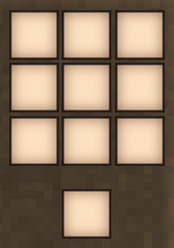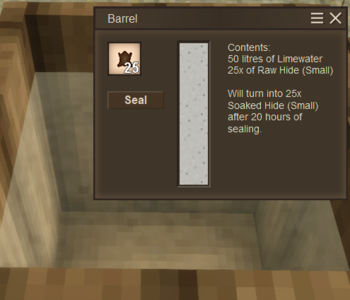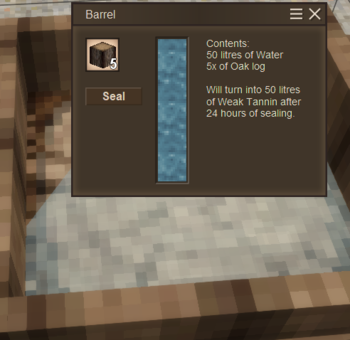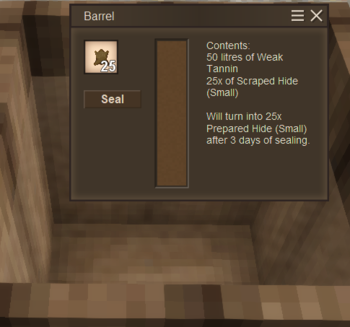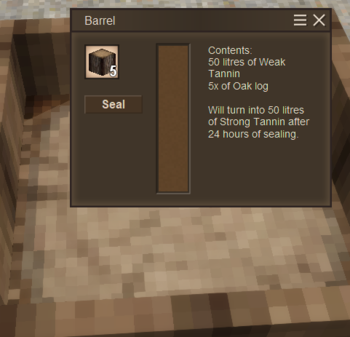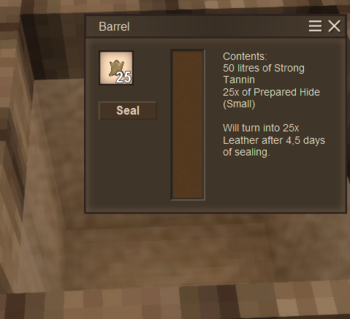Peletería
La Peletería es una serie especializada de recetas de barril que los jugadores pueden utilizar para convertir pieles crudas en cuero.
Materiales necesarios
Para crear cuero, un jugador necesita:
- Un suministro de cal o bórax en polvo.
- Un suministro de troncos de roble o acacia para fabricar tanino.
- Un cubo para trasladar líquido. Un cubo puede contener 10 unidades de líquido. En un cuenco cabe 1 litro.
- Barriles para procesar pieles crudas. Un barril puede contener hasta 50 unidades (o 5 cubos) de líquido.
- Pellejo crudo.
- Un cuchillo
- Un martillo o un molino de piedra
Pellejos
Los pellejos pueden obtenerse de animales salvajes o domésticos al morir. Los siguientes animales tienen la posibilidad de soltar pellejo:
- Pellejos Pequeños: Liebre, Mapache, Zorro, Borrego
- Pellejos Medianos: Jabalí, Hiena, Lobo
- Pellejos Grandes: Oveja cimarrona
- Pellejos Enormes: Oso
Cal y Bórax en polvo
La cal puede extraerse de piedra caliza suelta, piedra tiza suelta o conchas marinas. La piedra caliza y la tiza pueden triturarse con un martillo de tu inventario o molerse en un molino de piedra. Ambos métodos producen la misma cantidad de cal por piedra suelta; sin embargo, el uso de un martillo consumirá parte de la durabilidad de la herramienta, mientras que un molino no se daña con el uso repetido. Una piedra suelta produce una cal.
Una caracola produce dos cal. Las caracolas no pueden triturarse con un martillo y deben molerse en un molino.
La cal también puede utilizarse para fabricar cal viva, necesaria para producir yeso y mortero.
El bórax en polvo es una alternativa a la cal que puede extraerse moliendo un trozo de mineral de bórax en un molino. Un trozo de borax produce dos de bórax en polvo.
El bórax en polvo también es un material necesario en el proceso de forja de un yunque de hierro o hierro meteórico.
| Ingredients | Crafting Recipe |
|---|---|
| 1x Martillo 3x Piedra caliza |
Ejemplo de lista de la compra
Para procesar 8 cueros, que serían suficientes para fabricar 1 mochila de cuero, el jugador necesitaría los siguientes materiales (redondeados entre paréntesis):
- Troncos de Roble o Acacia: 3 para pellejos pequeños o 6 para pellejos medianos, grandes o enormes
- Cal o bórax en polvo - una piedra de cal o tiza puede molerse en una cal; uno de bórax puede molerse en dos bórax en polvo.
- Cal: 8 para pequeño, 17 (20) para mediano, 19 (20) L para grande y 20 L para enorme
- Bórax en polvo: 4 para los pequeños u 8 para los medianos, grandes o enormes.
- Pellejos: 8 pequeños, 4 medianos, 3 grandes o 2 enormes
- Agua de cal o bórax diluido: 8 (10) L para pequeñas, 17 (20) L para medianas, 19 (20) L para grandes y 20 L para enormes.
- Tanino débil: 16 (20) L para pequeño, 34 (40) L para mediano, 38 (40) L para grande y 40 L para enorme - de los cuales la mitad se convertirán en:
- Tanino fuerte: 8 (10) L para pequeño, 17 (20) L para mediano, 19 (20) L para grande y 20 L para enorme.
Secuencia de Procesamiento del Pellejo
Los jugadores sólo pueden procesar un tamaño de pellejo a la vez: pequeña, mediana, grande o enorme. Además, cada uno de los tamaños utiliza diferentes cantidades de solución. Un pellejo enorme, grande, mediano o pequeño requiere 10, 6, 4 o 2 litros respectivamente.
Los diferentes tamaños de los pellejos también dan diferentes cantidades de cuero tras el procesado final. Un pellejo enorme, grande, mediano y pequeño produce 5, 3, 2 y 1 piel respectivamente.
El siguiente cuadro muestra los requisitos para fabricar un barril completo de cada solución, tal como se utiliza más adelante en las respectivas fases de elaboración:
| Líquido base | Disolvente | Rinde 1 barril completo de |
|---|---|---|
| 50 L Agua | 50 Cal | Agua de cal |
| 50 L Agua | 20 bórax en polvo | Bórax diluido |
| 50 L Agua | 5 troncos de roble/acacia | Tanino débil |
| 50 L Tanino fuerte | 5 troncos de roble/acacia | Tanino fuerte |
Paso 1: Agua de cal o bórax diluido
To make soaked hides, limewater or diluted borax may be used:
- Limewater: 1 liter of water and 1 lime makes 1 liter of limewater - which means a full barrel of limewater requires 50 lime.
- Diluted borax: 5 liters of water and 2 powdered borax make 5 liters of diluted borax - which means a full barrel of diluted borax requires 20 powdered borax.
To make either limewater or diluted borax, it is not required to seal the barrel or wait for a processing time. Simply add the required amount of lime or powdered borax to a barrel filled with the required amount of water; if the ratio is correct, the water will instantly change into limewater or diluted borax. If the player is unsure about the correct ratio, simply fill the barrel with the amount of water and keep adding lime or powdered borax one by one until the change happens.
Once the player has acquired the necessary lime or borax solution, the raw hides can be placed inside the barrel, after which it needs to be sealed for 20 in-game hours to turn into soaked hides. Similar to the above process, a specific ratio must be reached. The player can start with one hide and check the barrel tooltip; it should display the amount of liquid solution and input hides as well as the possible output. If there is no output shown, the player placed too many hides in the barrel for the available amount of liquid.
Step 2: Scraping Hides
Once the raw hides have been soaked long enough, they will turn into soaked hides. These cannot directly be further processed in barrels; another crafting step comes in between. The player needs to put the soaked hides and a knife into the inventory crafting grid to process them into scraped hides. Please note that the knife will lose durability in the process.
| Ingredients | Crafting Recipe |
|---|---|
| 1x Cuchillo 1x Pellejo remojado |
Step 3: Weak Tannin
To make weak tannin, the player needs 10 units of water per oak/acacia log. After inputting the oak log, the barrel tooltip will display the materials present as well as the predicted output. The barrel must be sealed for 24 in-game hours to actually produce weak tannin; it cannot be sealed if an unbalanced ratio of water and oak logs are present in the barrel.
After the player acquired weak tannin with the above procedure, place the scraped hides into the weak tannin solution. Again, further processing of the hides requires sealing in the barrel - after 4 in-game days they will become prepared hides. Similar to the previous processes, a specific ratio must be reached. The player can start with one hide and check the barrel tool tip; it should display the possible output. If there is no output shown, the player placed too many hides in the barrel for the available amount of liquid, and the player will not be able to seal it.
Step 4: Strong Tannin
To make strong tannin, the player needs 10 liters of weak tannin per oak/acacia log. After inputting the log, the barrel tooltip will display the materials present as well as the predicted output. The barrel must be sealed for 24 in-game hours to actually produce strong tannin; it cannot be sealed if an unbalanced ratio of water and oak logs are present in the barrel.
After the player acquired strong tannin with the above procedure, place the prepared hides into the strong tannin solution. Again, further processing of the hides requires sealing in the barrel; after another 4.5 in-game days they will become leather. Similar to the previous processes, a specific ratio must be reached. The player can start with one hide and check the barrel tooltip; it should display the possible output. If there is no output shown, the player placed too many hides in the barrel for the available amount of liquid, and the player will not be able to seal it.
After waiting for the sealed hides to process, the player will be rewarded with the respective amount of leather ready to be used in crafting.
Pellejo Tratado
A diferencia del cuero, fabricar pieles tratadas es relativamente fácil.
Curado de pellejos
To create pelts, only two steps need to be followed. First, raw hides need to be oiled. This can be done by combining raw hide and fat in the crafting grid using the following ratio: 4 small hide + 1 fat, 2 medium hide + 1 fat, 1 large hide + 1 fat or 1 huge hide + 2 fats.
| Ingredients | Crafting Recipe |
|---|---|
| 1x Grasa 1x Pellejo crudo |
En un segundo paso, hay que "curar" estas pieles engrasadas, lo que no significa otra cosa que dejarlas intactas durante cierto tiempo. No hay ningún proceso y el lugar de almacenamiento es indiferente: el jugador puede llevarlas en el inventario o dejarlas en un contenedor de almacenamiento. El tooltip del objeto informará de cuánto ha progresado la curación.
Una vez completamente curadas, las pieles engrasadas se convertirán en pieles tratadas que podrán utilizarse en diferentes recetas de fabricación.
Usos
Las pieles tratadas medianas o grandes son necesarias para fabricar la mochila de cazador, una variante más barata de la mochila de cuero con sólo 4 ranuras, así como las recetas de armadura laminar y de ropa de piel. Las pieles pequeñas o medianas son necesarias para la receta del arco largo.
| Ingredients | Crafting Recipe |
|---|---|
| 15x Juncos 1x Pellejo (Grande) |
Video Tutoriales
| Explicación detallada de cómo fabricar cuero |
|---|
| Wiki Navigation | |
|---|---|
| Vintage Story | Guías • Preguntas más frecuentes (FAQ) • Vintage Story Original Soundtrack • Versiones • Controles |
| Mecánicas de juego | Fabricación • Talla Lítica • Alfarería • Herrería • Cocina • Temperatura • Hambre • Minería • Estabilidad temporal • Energía mecánica • Comercio • Agricultura • Ganadería |
| Mundo | Generación del Mundo • Biomas • Clima • Tormentas temporales |
| Objetos | Herramientas • Armas • Armadura • Ropa • Mochilas • Materiales • Comida |
| Bloques | Terreno • Plantas • Decorativo • Iluminación • Functional • Minerales |
| Entidades | Entidades hostiles • Animales • NPCs • Jugadores |
| Miscellaneous | List of client commands • Lista de comandos del servidor • Creative Starter Guide • Bot System • Cómo utilizar Worldedit • Cinematic Camera • Adjustable FPS Video Recording • ServerBlockTicking |
